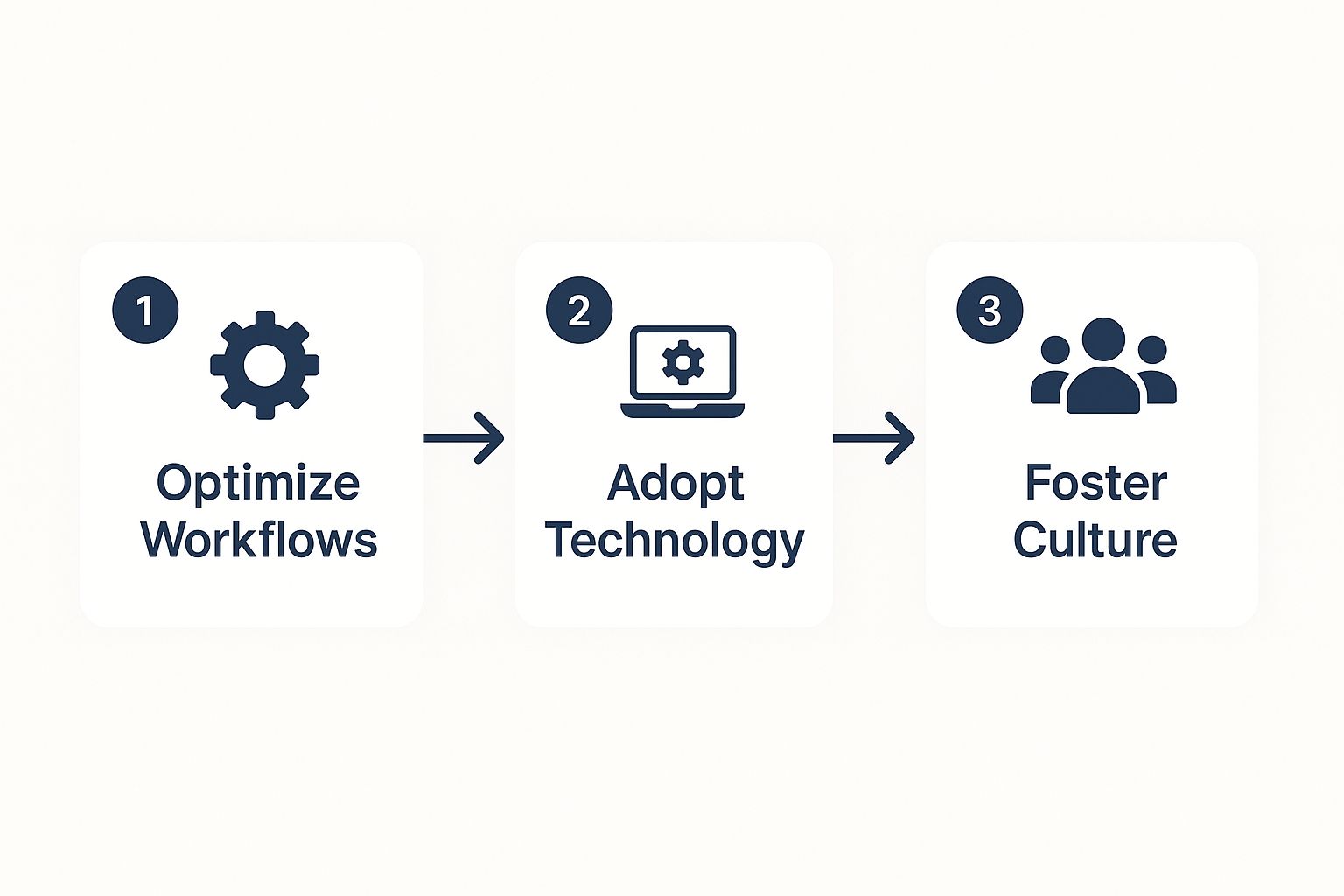Boosting your team's productivity isn't about cracking a whip or demanding longer hours. It’s about getting out of their way. Real, sustainable improvement comes from smoothing out the bumps in the road, which usually fall into three buckets: fine-tuning your workflows, being smart about your tech stack, and building a culture that supports focus.
This isn't just about tracking hours; it's about building a system where your team can consistently do their best work.
What Really Drives Team Productivity
Let's ditch the old-school idea that productivity is just a number on a spreadsheet. It’s about achieving the right results with the least amount of friction. So many teams feel perpetually busy but never truly productive, and it's usually because they're swimming against a current of hidden obstacles—think back-to-back meetings that could have been emails, a messy jungle of software tools, and processes so vague nobody knows who owns what.
A huge part of this is what’s often called "work about work." These are the tasks that feel like work but don't actually move the needle on your core goals. According to some studies, employees spend a staggering 60% of their day just juggling apps, sitting in pointless meetings, or digging for information. That’s a massive productivity leak right there.
This guide is all about plugging those leaks.
The Three Pillars of a Productive Team
If you really want to improve how your team operates, you can't just throw a few productivity hacks at them and hope for the best. You need a solid foundation built on interconnected principles.
This isn't a simple checklist; it's a strategy.

As the visual shows, a strong, productive culture doesn't just appear out of nowhere. It's built on top of efficient workflows and the right technology—not the other way around.
By zeroing in on these three areas, you create an environment where high performance becomes the default, not something you have to force. If you're looking for a deeper dive, there are plenty of proven strategies to improve team productivity that reinforce this very approach.
The goal is to build a system where efficiency becomes second nature. When you remove the small, daily frustrations, you free up your team's collective brainpower to focus on what truly matters—innovation, problem-solving, and meaningful progress.
To get a quick overview of how these elements work together, here's a simple breakdown.
Key Pillars of High-Performing Teams
This table summarizes the core components of a highly productive team environment, providing a quick reference for the strategies we'll be discussing.
| Pillar | Core Principle | Primary Goal |
|---|---|---|
| Optimized Workflows | Clarity and Simplicity | Eliminate wasted effort and make it easy to do the right work. |
| Strategic Technology | Enablement, Not Overload | Provide tools that reduce friction and amplify human capabilities. |
| Supportive Culture | Trust and Psychological Safety | Create an environment where people feel empowered and focused. |
This framework shows that true productivity is about looking beyond individual performance and examining the entire ecosystem your team works in. In the next sections, we’ll get into the practical, actionable steps for each of these pillars, starting with how to dissect and improve your current workflows.
Untangling Your Workflows to Cut Out Wasted Effort
Ever feel like your team is running on a hamster wheel? They’re busy, putting in the hours, but not actually moving the needle. More often than not, the problem isn't a lack of effort—it’s a clunky, inefficient workflow. These hidden knots and tangles in your process create friction, forcing everyone to spend more energy figuring out how to do the work than actually doing it.
The first step is always the hardest: you have to make the invisible, visible. You can't fix a problem you can’t see, and most workflow snags are buried in the day-to-day chaos of tasks and handoffs.

Get Real with a Workflow Audit
Think of a workflow audit as drawing a treasure map, but instead of "X marks the spot," you're looking for bottlenecks. The goal is to trace a task from its very beginning all the way to completion, highlighting every single step, decision, and handoff. This process almost always uncovers some surprising inefficiencies.
I once worked with a software dev team that was completely bogged down. They felt slow, but couldn't pinpoint why. We sat down and mapped their entire process, from a new feature request to final deployment. The culprit became glaringly obvious: their Quality Assurance (QA) feedback loop was a disaster of scattered emails, random Slack DMs, and forgotten spreadsheet notes.
The fix was simple. We moved all QA feedback into a dedicated channel within their project management tool. Just by centralizing communication, they slashed their QA cycle time by a whopping 40%. Developers could jump on fixes immediately without the constant context switching, freeing them up to focus on what was next.
The goal of an audit isn't to point fingers. It's about finding the friction points in the system. It’s the process that’s broken, not the people.
Hunt Down and Eliminate Redundancies
Once you have that map laid out, you can start spotting the easy wins. Look for redundant steps, pointless approvals, and manual tasks that are begging to be automated.
Start by asking your team a few direct questions:
- "Why do we do it this way?" If the only answer you get is a shrug and "we've always done it that way," you've found a prime candidate for a change.
- "Does this step actually add value?" So many tasks exist purely out of habit. Be ruthless.
- "Can a tool do this for us?" Things like repetitive data entry or pulling weekly reports are perfect for automation.
A content team I know was burning hours every single week just chasing down approvals in long, confusing email chains. By setting up an automated approval stage in their project management tool, they freed up nearly five hours per week. That’s five more hours they could spend on creative, high-impact work. A great way to amplify this is by using tools to minimize digital distractions to keep everyone locked in on what matters.
Write Down a Playbook People Will Actually Use
Let's be honest, Standard Operating Procedures (SOPs) have a terrible reputation. Most people imagine dusty binders sitting on a shelf, completely ignored.
The trick is to create SOPs that are simple, visual, and a genuine lifeline for your team. A great SOP isn't a 50-page novel; it's a quick-start guide.
A truly useful SOP just needs three things:
- A Clear Goal: What is this process supposed to achieve? State it in one sentence.
- Step-by-Step Plays: Use a simple numbered list with clear, action-focused language. Throw in screenshots or quick video clips to make it foolproof.
- Roles & Responsibilities: Who owns each step? Make it crystal clear so there's never any confusion.
When you document the best way to get something done, you build consistency and quality into your team’s DNA. More importantly, you empower people to work on their own without needing constant hand-holding—a massive win for everyone's productivity. This level of clarity is just as crucial for customer-facing processes. For instance, knowing how to build a chatbot can essentially serve as a powerful SOP for handling common customer questions, scaling support without scaling your team.
This whole process—auditing, refining, and documenting—fundamentally changes how a team works. It’s the difference between being "busy" and being truly effective, creating a rock-solid foundation for high performance.
7. Weave Technology and AI Into Your Workflow
The right tools can be a game-changer for your team's productivity, but simply piling on more apps often creates more noise than signal. The goal is to make technology serve your team, not the other way around. This means being incredibly deliberate about the tools you adopt, ensuring they solve real problems instead of just adding another login to everyone's list.
A cluttered digital workspace is just as distracting as a messy physical one. Constant notifications and the need to jump between ten different apps for a single task—a phenomenon known as context switching—drains mental energy and absolutely kills focus. The key is to simplify, consolidate, and automate wherever you can.

Conduct a Ruthless Tech Stack Audit
Your first move should be a "tech stack audit." Get your team in a room (virtual or physical) and lay out every single piece of software you currently use. I'm talking everything from major project management platforms like Asana to small, single-purpose browser extensions. Be brutally honest about what’s actually helping and what’s just collecting digital dust.
During this audit, ask these critical questions about each tool:
- Does this solve a unique problem? If two or three apps are doing the same job, it's time to pick a winner and consolidate.
- How often is it actually used? Usage data doesn't lie. If a paid tool has been sitting idle for months, it’s probably not as essential as you thought.
- Does it integrate with our core systems? A tool that doesn’t "talk" to your other software often creates more manual work than it saves.
The whole point here is to trim the fat. For instance, if your team is using Slack for quick chats, email for formal updates, and a separate app for project comments, you have a communication problem. Consolidating all project-related discussions into one central hub can drastically improve clarity and cut down the time spent hunting for that one specific comment.
Let AI Handle the Repetitive Work
Artificial intelligence isn't some far-off concept anymore; it's a practical tool that can seriously supercharge your team's output. The real magic of AI in the workplace is its ability to take on the repetitive, soul-crushing tasks that bog people down. This frees them up to focus on the creative, strategic work that actually moves the needle.
The strategic adoption of artificial intelligence is a massive driver of modern productivity. Companies actively using AI report a 72% productivity boost and a 59% improvement in job satisfaction, underscoring its impact.
AI can be a powerful assistant for nearly every role. A sales team can use AI to draft personalized follow-up emails in seconds, saving hours each week. A marketing team can use it to analyze campaign data, pulling out key insights that would have taken days to uncover manually. Even customer support can see huge gains; our guide on how to automate customer service explores how AI chatbots can handle common queries, freeing up human agents for more complex issues.
To see how this works in practice, here are a few common bottlenecks and the AI tools that can help solve them.
AI Tools for Common Productivity Bottlenecks
| Productivity Challenge | Example AI Tool | How It Boosts Productivity |
|---|---|---|
| Meeting Overload & Follow-up | Fireflies.ai | Transcribes meetings, summarizes action items, and creates a searchable record, eliminating the need for manual note-taking. |
| Writer's Block & Content Creation | Jasper | Generates drafts for blog posts, social media updates, and marketing copy, giving your team a strong starting point. |
| Repetitive Administrative Tasks | Zapier | Automates workflows between different apps (e.g., automatically creating a Trello card from a new Gmail), removing manual data entry. |
| Inefficient Project Management | ClickUp AI | Summarizes long comment threads, suggests subtasks for larger projects, and helps generate project status updates instantly. |
Choosing the right tool is about matching a specific pain point with a targeted solution, not just grabbing the shiniest new toy.
How to Choose Tools That Actually Fit Your Team
It's easy to get distracted by flashy features when you're evaluating new tech, especially AI tools. A much better approach is to use a simple framework that keeps you focused on solving a real problem. Before you commit to anything new, make sure it ticks these boxes.
- Start with the Problem: First, clearly define the bottleneck. Are you trying to cut down on meeting time? Speed up content creation? Improve customer response times? Don't buy a tool and then go looking for a problem it can solve.
- Demand Seamless Integration: The new tool must play well with your existing tech stack. If it requires complex workarounds or manual data transfers, it’s going to create more friction than it removes.
- Prioritize User-Friendly Design: If a tool isn't intuitive, your team just won't use it. Look for solutions with a gentle learning curve that don't require weeks of training to become useful.
This structured evaluation helps you pick solutions that integrate smoothly and deliver value right away. By being intentional with your technology, you can build a digital ecosystem that actively boosts your team instead of holding it back.
Build a Culture That Breeds Engagement and Focus
Even the slickest workflows and the most powerful tools are useless in a toxic or disengaged environment. At the end of the day, the human element is the ultimate productivity multiplier. It all comes down to creating a space where people feel trusted, motivated, and safe enough to do their best work.
When your team is afraid to ask questions, pitch a wild idea, or admit they’re stuck, innovation dies. Psychological safety isn't just a fluffy "nice-to-have"—it's the absolute bedrock of any high-performing team. It's the unspoken permission to be human, take smart risks, and work together without constantly looking over your shoulder.

Foster Psychological Safety
This kind of environment has to start at the top. It’s all about leadership modeling the behavior you want to see. When a manager openly says, "I'm not sure, what do you all think?" or admits, "My mistake, here's how I'll fix it," they're sending a powerful signal that it’s okay for everyone else to do the same.
You can actively weave this into your daily interactions:
- Champion curiosity. When someone asks a question, treat it as a valuable contribution, not an annoying interruption.
- Separate ideas from egos. Critique the suggestion, not the person. Phrases like, "Let's dig into that idea," are worlds better than, "You're wrong."
- Swap blame for solutions. When a mistake happens, the question shouldn't be, "Who did this?" It needs to be, "How can we make sure this doesn't happen again?"
This one shift can completely transform a team's dynamic. You move from a culture of self-preservation to one of collective ownership, where everyone is pulling in the same direction.
Connect Daily Grind to the Bigger Picture
Let's be honest, nobody wants to feel like a cog in a machine. People hit their stride when they understand why their work actually matters. A leader's job is to constantly connect the dots between someone's daily tasks and the company's grander mission.
Never assume your team just gets it. Spell it out for them.
It's the difference between saying, "Please update the customer onboarding docs," and framing it as, "Let's refine the onboarding docs so our new customers feel supported from day one and are way less likely to churn." Suddenly, it’s not just a chore—it’s a direct contribution to the bottom line.
When people feel a sense of purpose, their motivation goes through the roof. This is a far more powerful driver than any top-down pressure. Building these strong connections is crucial, and many lessons from customer engagement plans can be applied internally to keep your team plugged into the mission.
Actively Fight Burnout
Burnout is the silent killer of productivity. Once exhaustion and disengagement take root, they spread like wildfire and are incredibly difficult to reverse. Unfortunately, the data shows this isn't a rare problem.
Recent stats paint a pretty grim picture: only 32% of U.S. workers report feeling engaged, while a shocking 66% say they're experiencing burnout. If you want to boost output, you have to invest in your people’s well-being.
Just telling people to "take a break" is not a strategy. You have to build safeguards against burnout right into your culture.
- Introduce "Focus Blocks." Encourage the team to block off chunks of their calendar for deep, uninterrupted work. Then, actually respect those blocks—no meetings!
- Set (and Model) Clear Boundaries. If you, as a leader, are firing off emails at 10 PM, you’re setting the expectation that your team should be online, too. Log off at a reasonable hour and encourage your team to fully disconnect.
- Celebrate the Small Wins. Don't wait for the massive project launch to give praise. A quick "great job" in the team channel for fixing a nasty bug or getting amazing client feedback does wonders for morale and keeps the momentum going.
By intentionally building a culture of engagement, purpose, and well-being, you create an environment where people want to be productive. It’s not something you have to force—it becomes the natural result of a healthy, supportive workplace.
Measuring What Matters for Continuous Improvement
If you really want to make lasting improvements to how your team works, you have to track your progress. But let's be clear: this isn't about micromanagement or installing creepy software to count keystrokes.
Real measurement is about focusing on meaningful, outcome-driven metrics that actually empower your team, not police them.
The old way of thinking—that hours spent at a desk equal value created—is completely broken. A team pulling 60-hour weeks isn't automatically more productive than one working 40. In fact, they're probably just closer to burning out. The real goal is to shift your focus from inputs (time) to outputs (results).
Find Your Outcome-Driven Metrics
The only metrics worth tracking are the ones your team can directly influence and that tie back to a clear business goal. These will look different for every team, but the core idea is always the same: measure the result, not just the activity.
Think about what a specific team is really there to do. What does success actually look like for them?
- For a customer support team: Instead of just counting tickets closed per hour, start measuring the first-contact resolution rate. This one change shifts the entire focus from raw speed to quality, encouraging agents to solve the problem for good on the first try.
- For an engineering team: Forget about counting lines of code. A much better metric is cycle time—the total time it takes to get from starting a task to deploying it. This gives you a true picture of efficiency, covering everything from coding to review and release.
- For a sales team: Call volume might seem important, but a far more powerful metric is the lead-to-opportunity conversion rate. This tells you how good the team is at turning a flicker of interest into a real, tangible sales opportunity.
When you focus on metrics like these, you start encouraging the right behaviors. You give your team a clear, meaningful target to shoot for. It’s all about working smarter, not just harder.
The most powerful metrics are leading indicators of success. They provide feedback that allows a team to adjust its course before a project is finished, rather than just grading them after the fact.
Build a Simple Visual Dashboard
Data is completely useless if it’s buried in a complicated spreadsheet that no one ever looks at. To make your metrics actionable, they have to be visible and incredibly easy to understand at a glance.
A simple, shared dashboard is the perfect tool for this. It doesn't need to be fancy. Tools like Geckoboard, Databox, or even a well-structured Trello board can work wonders. The key is to display just the one or two core metrics your team is focused on improving.
I once worked with a marketing team struggling with their content velocity. We set up a dead-simple dashboard tracking just two things: average time from idea to publication and number of articles published per month. By seeing these numbers update in real-time, they could instantly spot where their review process was getting bogged down and take ownership of fixing it themselves.
This approach turns metrics from a tool of top-down scrutiny into one of self-management.
Use Data to Empower, Not Punish
How you talk about these numbers is just as important as what you’re tracking. You have to frame them as tools for the team to get better together, not as a stick to punish someone for a bad week.
Here’s how to build a healthy, data-informed culture:
- Involve the Team: Don't just hand down metrics from on high. Let the team help decide what to track. When they have a say in the process, they'll have far more ownership over the results.
- Focus on Trends: Look at trends over time, not daily blips. A single bad day doesn't mean the whole system is broken. It’s the overall pattern that tells the real story.
- Celebrate Improvements: When a metric moves in the right direction, make a big deal out of it! This reinforces that the goal is progress and builds positive momentum.
At the end of the day, measuring what matters gives your team a scoreboard for their own game. It provides the real-time feedback they need to spot opportunities, make smarter decisions, and take genuine ownership of their collective success.
Got Questions About Boosting Team Productivity?
It’s completely normal to have questions when you're trying to improve how your team works. The whole idea can feel daunting, and it's easy to get stuck wondering where to even begin or worrying about creating more problems than you solve.
Let’s cut through the noise. The good news is that you don't need to blow up your entire workflow. Real, lasting improvements come from making small, smart changes that build on each other over time.
"Where Do I Even Start?"
The sheer number of productivity hacks and tools out there is enough to give anyone analysis paralysis. The secret is to ignore all of them for now and focus on one thing: the biggest point of friction your team is facing right now.
Don't try to boil the ocean. Pick one specific bottleneck and commit to fixing just that for the next month.
- Drowning in meetings? Try a "no-meeting Wednesday" or make a simple rule that no meeting gets accepted without a clear agenda.
- Is communication a total mess? Get everyone to agree that all project talk happens in one specific Slack channel or Asana task. No more hunting through emails and DMs.
- Are deadlines always slipping? Do a quick audit of your workflow. Just map out the steps and ask the team, "Where do things get stuck?"
When you focus your energy like this, you see results fast. That quick win builds momentum and, more importantly, shows your team that these changes actually make their work easier.
"How Do I Measure Productivity Without Micromanaging?"
This is a big one. Nobody wants to feel like Big Brother is watching their every move. The goal is to empower your team, not track their every click.
The key is a simple shift in mindset: measure outcomes, not activity.
Forget about counting hours logged, emails sent, or lines of code. Those are vanity metrics. Instead, focus on things that show real progress toward your shared goals. This builds trust and gives everyone a sense of ownership.
For a software team, stop tracking individual commits. Instead, measure the team's collective cycle time—how long it takes an idea to go from a concept to being live for customers. That one metric gets everyone focused on the same thing: shipping value.
Your metrics should feel like a team scoreboard, not a principal's report card.
"What If My Team Hates These Changes?"
Let's be real: change is uncomfortable, and you'll probably hit some resistance. That's totally normal. The best way to get around it is to be transparent and bring everyone into the process.
People will get behind a new idea if they understand why it's happening and feel like they have a say.
Here are a few things that have always worked for me:
- Frame it as a test. Don't roll out a permanent new rule. Instead, say, "Hey team, let's try this for two weeks and see if it helps. If not, we'll scrap it." This makes people much more willing to give it an honest shot.
- Ask for their help. Your team knows where the problems are better than anyone. Involve them in brainstorming solutions. When they help build the new system, they're way more invested in its success.
- Show them what's in it for them. Connect the change directly to a pain point they have. "I know everyone hates doing that tedious Friday report. This new automation will get rid of it completely."
When your team sees you’re trying to remove headaches, not add rules, they'll quickly become your biggest supporters.
Ready to eliminate communication bottlenecks and give your team the instant answers they need? ChatbotGen lets you build a powerful AI knowledge base from your existing documents in minutes. Empower your team to find information instantly and stay focused on their most important work. Start your free trial.
